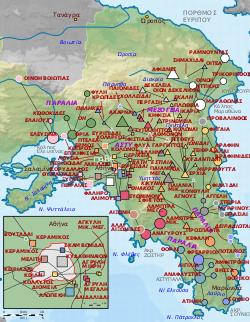
Back Attika ALS አቲካ Amharic أتيكا Arabic اتيكا ARZ Ática AST Attika Azerbaijani Attika (Landschoft) BAR Атыка Byelorussian Атика Bulgarian Attika Breton
Attica
Αττική | |
|---|---|
 View from Kaisariani Hill looking towards Athens agglomeration, with Salamis visible in the background | |
 Map of municipalities (demoi) in ancient Attica | |
| Location | Central Greece |
| Major cities | Athens |
| Dialects | Attic |
| Key periods | Athenian Empire (477–404 BC) Second Athenian League (378–338 BC) |
Attica (Greek: Αττική, Ancient Greek Attikḗ or Attikī́, Ancient Greek: [atːikɛ̌ː] or Modern: [atiˈci]), or the Attic Peninsula, is a historical region that encompasses the entire Athens metropolitan area, which consists of the city of Athens, the capital of Greece and the core city of the metropolitan area, as well as its surrounding suburban cities and towns. It is a peninsula projecting into the Aegean Sea, bordering on Boeotia to the north and Megaris to the west. The southern tip of the peninsula, known as Laurion, was an important mining region.
The history of Attica is tightly linked with that of Athens. In ancient times, Attica corresponded with the Athens city-state. It was the most prominent region in Ancient Greece, specifically during the Golden Age of Athens in the classical period. Ancient Attica (the classical Athens city-state) was divided into demoi, or municipalities, from the reform of Cleisthenes in 508/7 BC, grouped into three zones: urban (astu) in the region of Athens main town, and Piraeus (the port), coastal (paralia) along the coastline, and inland (mesogeia) in the interior.
The modern administrative region of Attica is more extensive than the historical region, and includes Megaris as part of the regional unit of West Attica, the Saronic Islands and Cythera, as well as the municipality of Troizinia on the Peloponnesian mainland.
© MMXXIII Rich X Search. We shall prevail. All rights reserved. Rich X Search